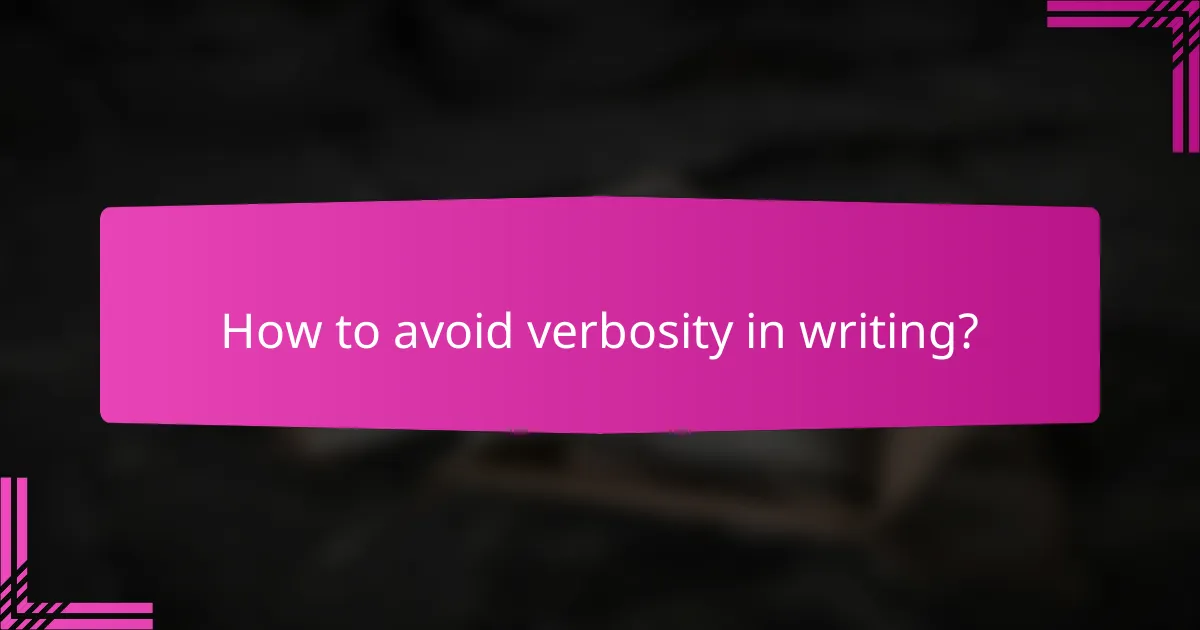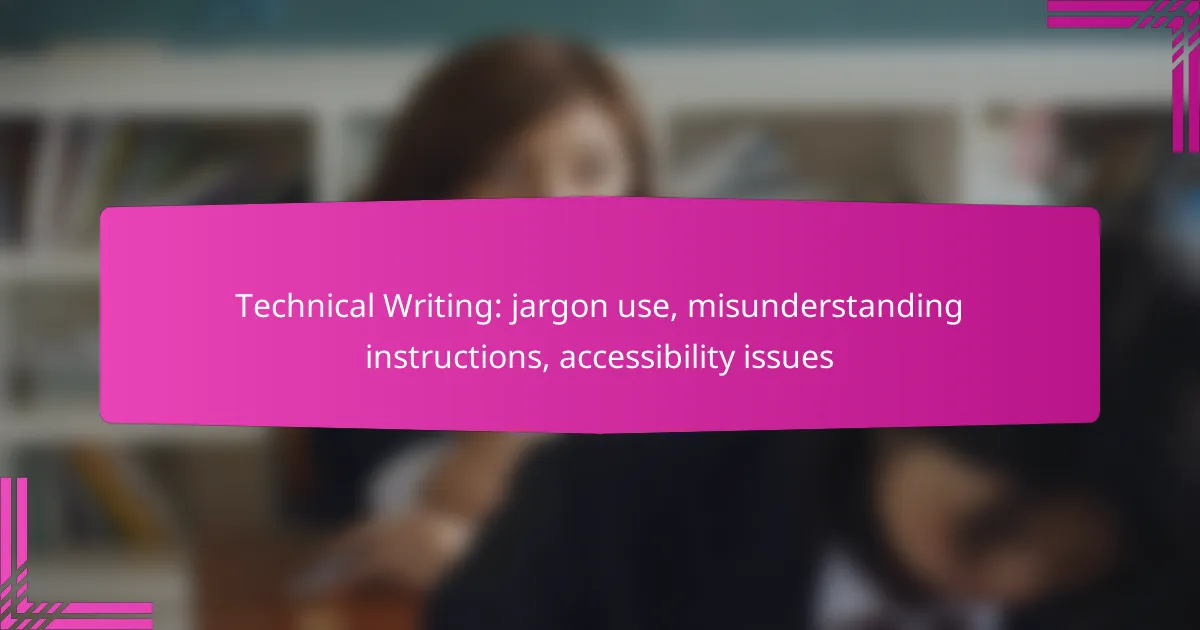Effective writing requires clarity and focus to engage readers and convey essential messages. By avoiding verbosity and organizing content logically, writers can enhance comprehension and maintain interest. Implementing clear language and structured formats helps prevent overwhelming readers, ensuring that the core message remains impactful.

How to avoid verbosity in writing?
Avoiding verbosity in writing involves using clear and concise language while focusing on essential messages. By implementing effective editing techniques and engaging with peers, writers can enhance clarity and maintain reader interest.
Use concise language
Concise language eliminates unnecessary words and phrases, making your writing clearer. Aim for short sentences that convey your message directly, avoiding jargon unless it is essential for your audience.
For example, instead of saying “due to the fact that,” simply use “because.” This small change can significantly improve readability.
Focus on key messages
Identify the primary messages you want to communicate and prioritize them throughout your writing. This focus helps maintain clarity and prevents you from straying into unrelated topics.
Consider creating an outline that highlights these key points before you start writing. This will serve as a roadmap to keep your content on track.
Implement editing techniques
Effective editing is crucial for reducing verbosity. After writing, take a break and then review your work with fresh eyes, looking specifically for redundant phrases and unnecessary details.
Utilize tools like readability checkers to assess sentence length and complexity, ensuring your writing remains accessible to your intended audience.
Utilize bullet points
Bullet points can simplify complex information and highlight essential details. Use them to break down lists or key points, making your content easier to scan and understand.
- Keep bullet points brief.
- Start each point with a strong action verb.
- Avoid complete sentences unless necessary for clarity.
Engage in peer reviews
Peer reviews provide valuable feedback on your writing’s clarity and conciseness. Sharing your work with colleagues can reveal areas where verbosity may have crept in.
Encourage peers to focus on specific aspects, such as whether your main ideas are clear and if any sections feel overly wordy. This collaborative approach can enhance the overall quality of your writing.

What are the risks of losing focus in content?
Losing focus in content can lead to several significant risks, including reader disengagement, decreased comprehension, and a negative impact on SEO. These issues can undermine the effectiveness of your message and reduce the overall quality of your content.
Reader disengagement
When content strays from its main topic, readers may lose interest and disengage. This can happen if the writing becomes too verbose or includes irrelevant information that distracts from the core message.
To maintain reader engagement, ensure that every paragraph contributes to the central theme. Use clear and concise language, and avoid unnecessary tangents that could lead to boredom.
Decreased comprehension
Losing focus can significantly hinder a reader’s ability to understand the content. When information is scattered or overly complex, it becomes challenging for readers to grasp the key points.
To enhance comprehension, structure your content logically and use headings to guide readers through the material. Summarizing key ideas at the end of sections can also help reinforce understanding.
Negative impact on SEO
Content that lacks focus can adversely affect search engine optimization (SEO). Search engines prioritize relevant and coherent content, so if your writing is disorganized, it may rank lower in search results.
To improve SEO, focus on keyword relevance and ensure that your content addresses specific topics clearly. Regularly updating and refining your content can also help maintain its search engine visibility.

How can overwhelming readers be prevented?
To prevent overwhelming readers, it’s essential to present information in a clear and digestible manner. This involves organizing content logically, using visual aids, and maintaining a structured format that guides the reader through the material.
Segment information logically
Segmenting information logically helps readers process content more easily. Break down complex topics into smaller, manageable sections, each focusing on a single idea or theme. This approach allows readers to absorb information without feeling inundated.
Consider using headings and subheadings to delineate sections. For example, if discussing a product, you might divide the content into features, benefits, and user testimonials. This structure aids comprehension and retention.
Incorporate visual aids
Visual aids such as images, charts, and infographics can significantly enhance understanding. They provide a visual representation of data, making it easier for readers to grasp complex concepts quickly. For instance, a pie chart can illustrate market share more effectively than a lengthy paragraph.
When using visual aids, ensure they are relevant and clearly labeled. Avoid cluttering the page with too many visuals, as this can detract from the main message. A good rule of thumb is to include one visual per key point to reinforce the information without overwhelming the reader.
Maintain a clear structure
A clear structure is vital for guiding readers through your content. Start with an introduction that outlines the main points, followed by the body where each point is elaborated, and conclude with a summary or call to action. This logical flow helps readers anticipate what comes next.
Utilize bullet points or numbered lists to present information succinctly. For example, if outlining steps in a process, a numbered list can clarify the sequence and importance of each step. This not only improves readability but also helps readers follow along without confusion.

What are the best practices for clear writing?
Clear writing involves several best practices that enhance comprehension and engagement. Key strategies include defining your target audience, establishing a clear purpose, and utilizing active voice to convey messages effectively.
Define target audience
Understanding your target audience is crucial for clear writing. Knowing who will read your content helps you tailor your language, tone, and complexity to meet their expectations and needs.
Consider factors such as age, education level, and interests when defining your audience. For example, technical jargon may be appropriate for industry professionals but confusing for general readers.
Establish a clear purpose
A clear purpose guides your writing and keeps it focused. Determine whether you aim to inform, persuade, or entertain your audience, and ensure every part of your content aligns with that goal.
For instance, if your purpose is to inform, avoid unnecessary details that might distract from the main message. A concise outline can help maintain clarity and direction throughout your writing process.
Utilize active voice
Using active voice makes your writing more direct and engaging. In active voice, the subject performs the action, which typically results in clearer and more vigorous sentences.
For example, instead of saying “The report was written by the team,” say “The team wrote the report.” This shift not only clarifies who is responsible but also energizes your prose.

How does descriptive style impact affiliate marketing?
Descriptive style in affiliate marketing can significantly influence how effectively a message resonates with the audience. While it can enhance engagement through vivid imagery and detail, excessive verbosity may overwhelm readers and dilute the core message.
Influences reader trust
A descriptive style can build reader trust by providing detailed, relatable content that resonates with their experiences. When affiliate marketers use clear and engaging descriptions, they create a sense of authenticity that encourages readers to believe in the recommendations being made.
However, if the descriptions become overly complex or filled with jargon, it can lead to confusion and skepticism. Striking a balance between detail and clarity is essential to maintain credibility.
Affects conversion rates
The effectiveness of a descriptive style can directly impact conversion rates. Engaging descriptions that highlight the benefits and features of a product can motivate readers to take action, such as clicking a link or making a purchase.
Conversely, if descriptions are too lengthy or meandering, potential customers may lose interest and abandon their intent to buy. Keeping descriptions concise yet informative is key to optimizing conversions.
Shapes brand perception
Descriptive style plays a crucial role in shaping how a brand is perceived in the market. Well-crafted descriptions can convey a brand’s personality and values, making it more appealing to the target audience.
On the other hand, a lack of focus or an overly verbose approach can lead to a negative perception, suggesting that the brand lacks professionalism or clarity. Consistency in descriptive style across marketing materials helps reinforce a strong brand identity.



